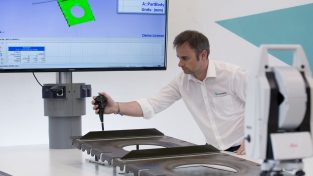In this episode of HxGN RADIO, we discuss Hexagon’s acquisition of Sigma Space, which offers next generation LiDAR technology to deliver high quality 3D maps of the earth.
Welcome to HxGN Radio. This is your host Michelle Jacobi. Accurate and geo-referenced 3D visualizations have become an absolute necessity due to the detailed insight they provide – from urban planning and emergency services to aviation safety and disaster response. Recently acquired by Hexagon, Sigma Space, offers next generation LiDAR technology to rapidly deliver high quality 3D maps of the earth. Today in the studio we have Katie Fitzsimmons, Sigma Space director of operations, to talk about Sigma’s collaboration with the Hexagon family.
MJ: Katie, welcome and thank you for joining us today.
KF: Thank you.
MJ: Let’s start by telling our listeners a little bit about SigmaSpace and your role at the company.
KF: Sure, I’m the director or operations and the program manager for our Single Photon LiDAR programs. Sigma is a unique company, we have small agile teams that are rapidly develop next generation technology. I love working at Sigma because we are a leading technology development group with small teams with smart engaged people. It’s very rewarding to work with a group of people who are really committed to seeing a program succeed doing whatever it takes.
MJ: Can you describe what Sigma Space does and the type of solutions you offer?
KF: Sure, Sigma is a technology development company that provides instruments, data and engineering services to NASA, the department of defense in the US and commercial customers.
MJ: Those are some very important customers and people you deal with.
KF: Definitely.
MJ: What customer challenges does Sigma Space technology help address and how do SigmaSpace’s solutions help solve these problems.
KF: Well our Single Photon LiDAR systems makes a capture of high resolution 3D data of the US and the world achievable due to the efficieny and the low cost. This is something that’s never been done before. In addition, Sigma’s line of micro-pulse LiDAR sensors are providing feedback to meteorological and environmental agencies who monitor atmospheric data to help manage pollution, planetary boundary layer and aerosol at sites all over the world. For instance, NASA’s carbon monitoring program, whose mission is to monitor carbon content in forests. Carbon sequestration into forest is one of the main channels for absorption of carbon into the atmosphere. To have accurate measurements of carbon content of forest is fundamental for accurate modeling of carbon balance and eventually accurate carbon credit system. The program used SPL, single photon LiDAR, to obtain high resolution 3D maps of forest areas to obtain much more accurate representation of the forest than they’ve previously done. Their goal is to eliminate boots on the ground in evaluating forest and SPL will help get them there.
In a completely different line of Sigma’s products, the atmospheric LiDAR line, Sigma recently partnered with MeteoFrance to provide monitoring of air quality for aircraft throughout France. We started working with MeteoFrance after the 2010 volcanic eruption in Iceland that caused delays and disruption of air traffic all over Europe. MeteoFrance is using a network of Sigma Space’s MicroPulse LiDAR sensors to monitor atmospheric particulates and ensure that air traffic can travel safely in the case of another eruption. The network provides feedback on air quality 24/7 making it a critical tool for the agency to ensure safe air travel.
MJ: Wow that’s some amazing customer stories and examples you have there. I’m definitely thankful for you guys and the technology you offer. So I mentioned earlier that Hexagon recently acquired Sigma Space. What does the Hexagon acquisition mean to SigmaSpace and could you talk a little bit about the two organizations and how they’re joining forces?
KF: Absolutely. The acquisition with Sigma Space by Hexagon has been very symbiotic. Sigma is a hardware company at heart and we’ve been very fortunate to work with the Leica Geosystems team which has tremendous engineering talent. Our two teams came together very naturally to discuss current technical challenges, but more importantly and certainly much more exciting, is the future of next generation development. In addition, we’ve also interacted with other Hexagon teams outside of GSD including HTC, the Hexagon Technology Center, and Intergraph Government Solutions to provide thoughts and feedback on new developments and synergies which is definitely rewarding for our team.
MJ: It sounds like you guys will just fit in perfectly.
KF: Yeah, so far it’s been a great match.
MJ: Excellent. So Hexagon empowers its customers to narrow the chasm between what is – the current status quo and what should be. This is what Hexagon’s calls “shaping smart change.” What does shaping smart change mean to you/SigmaSpace?
KF: Well I think what of the biggest examples is that Sigma plans to deliver more elevation data to the market than it’s ever seen before. With this data customers will be able to look at their environments at regional, state and even national levels, something that’s never been done, and we’re excited to see what new applications are created around the accessibility of high resolution 3D data.
MJ: What does 2016 and the next few years hold for Sigma Space and its customers?
KF: Well Sigma is really excited to participate in the Hexagon content program. This program will allow customers to access varying resolution, 3D data sets in North America and Europe, and Sigma Space is always looking at space applications for LiDAR technology. With our long history at NASA, Sigma has the expertise to launch Hexagon’s first space mission.
MJ: That’s pretty exciting. Katie thank you for time today, we really appreciate it and thank you for being out guest. Learn more about Sigma Space by visiting sigmaspace.com and tune into more episodes from HxGN Radio on iTunes, SoundCloud or Stitcher Radio. Thanks for listening.













![[PODCAST]: Hexagon and Sigma Space: Joining Forces](https://blog.hexagon.com/wp-content/uploads/2016/07/artworks-000170349341-kulfmm-t500x500-500x391.jpg)



